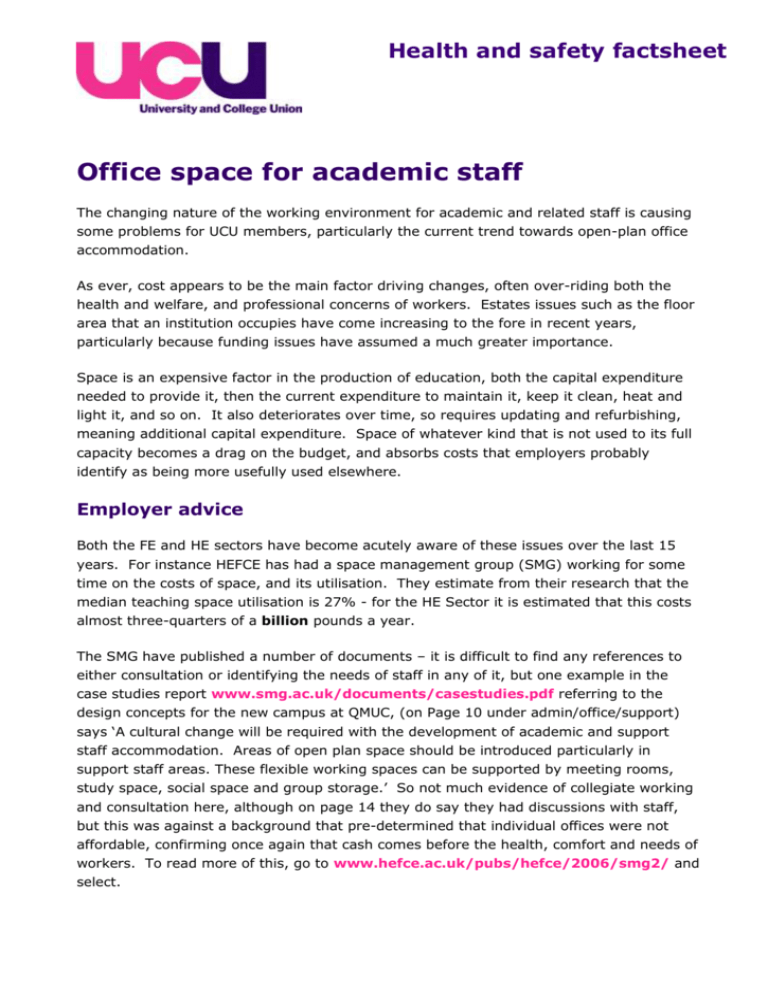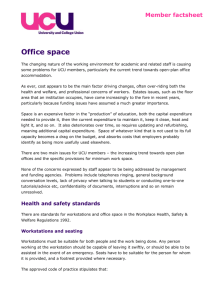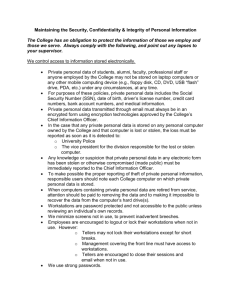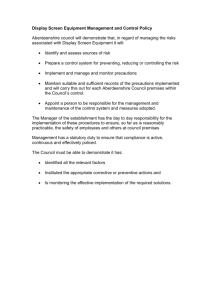Office space for academic staff
advertisement

Health and safety factsheet Office space for academic staff The changing nature of the working environment for academic and related staff is causing some problems for UCU members, particularly the current trend towards open-plan office accommodation. As ever, cost appears to be the main factor driving changes, often over-riding both the health and welfare, and professional concerns of workers. Estates issues such as the floor area that an institution occupies have come increasing to the fore in recent years, particularly because funding issues have assumed a much greater importance. Space is an expensive factor in the production of education, both the capital expenditure needed to provide it, then the current expenditure to maintain it, keep it clean, heat and light it, and so on. It also deteriorates over time, so requires updating and refurbishing, meaning additional capital expenditure. Space of whatever kind that is not used to its full capacity becomes a drag on the budget, and absorbs costs that employers probably identify as being more usefully used elsewhere. Employer advice Both the FE and HE sectors have become acutely aware of these issues over the last 15 years. For instance HEFCE has had a space management group (SMG) working for some time on the costs of space, and its utilisation. They estimate from their research that the median teaching space utilisation is 27% - for the HE Sector it is estimated that this costs almost three-quarters of a billion pounds a year. The SMG have published a number of documents – it is difficult to find any references to either consultation or identifying the needs of staff in any of it, but one example in the case studies report www.smg.ac.uk/documents/casestudies.pdf referring to the design concepts for the new campus at QMUC, (on Page 10 under admin/office/support) says ‘A cultural change will be required with the development of academic and support staff accommodation. Areas of open plan space should be introduced particularly in support staff areas. These flexible working spaces can be supported by meeting rooms, study space, social space and group storage.’ So not much evidence of collegiate working and consultation here, although on page 14 they do say they had discussions with staff, but this was against a background that pre-determined that individual offices were not affordable, confirming once again that cash comes before the health, comfort and needs of workers. To read more of this, go to www.hefce.ac.uk/pubs/hefce/2006/smg2/ and select. LSC has a similar concern about effective space utilisation, and the formal position in LSC Circular 02/20 again pays little attention to specific staff needs. At the time of writing, (June 2007) this document was not available on the website to download, but it is being revised in the light of current research. Concerns for academic, teaching and academic related staff None of the concerns expressed by such staff appear to be being addressed by management and funding agencies. Problems like telephones ringing, general background conversation levels, privacy when talking to students or conducting one-to-one tutorials/advice etc., confidentiality of documents, interruptions and so on remain unresolved. For more research-based information, the University of Minnesota ‘Informed Design’ website has abstracts related to buildings design and the work environment. The website is at www.informedesign.umn.edu, and you can register for regular updates. A search for ‘open plan offices’ finds 11 results: the paper Health Effects of Office Design is useful, www.informedesign.umn.edu/Rs_detail.aspx?rsId=2304 and Background Noise in Open-plan Offices www.informedesign.umn.edu/Rs_detail.aspx?rsId=1888 helps too. Health and safety standards There are also standards for workstations and office space in the Workplace Health, Safety & Welfare Regulations 1992. Regulation 11 - Workstations and Seating - requires workstations to be suitable for both people and the work being done. Any person working at the workstation should be capable of leaving it swiftly, or should be able to be assisted in the event of an emergency. Seats have to be suitable for the person for whom it is provided, and a footrest provided where necessary. The approved code of practice attached to the Regulation says (Paragraph 81) Workstations should be arranged so that work can be carried out safely and comfortably. Paragraph 83 requires adequate freedom of movement. Paragraph 84 says there shall be sufficient clear and unobstructed space to enable work to be done safely. Regulation 10 - Room dimensions and Space - requires that there should be sufficient floor area, height and unoccupied space for purposes of health, safety & welfare. College managements are very good at saying the space requirements for workrooms don't apply to staffrooms, because lecturers only spend a short period of time in them - the rest of the time they are in a lecture theatre, classroom, studio or workshop, but they are an important standard that can be used in negotiation with management. They require 11 cubic metres of 3D space per person, which the Regulations say is about 2.0 x 2.3 metres 2 floor area in a modern building with a ceiling height around 2.4 metres. The is some debate around whether or not this includes any furniture or equipment. The Display Screen Equipment Regulations 1992 also contain standards for computer workstations, and UCU should be pressing for lecturers to be categorised as users under these Regulations. This triggers further action under the Regulations including a workstation assessment with user input, workstation improvements; and eye tests. These must be provided free-of-charge if the user requests one, and should the eye test reveal the need for spectacles for use with the VDU these must be provided free of charge by the employer. While some employers resist user-designation for academic and related staff, institutional management increasingly uses electronic communication systems and intranet as the main source of information to staff, and for providing access to policies and procedures, administration, timetabling, teaching schemes etc., there are increasing amounts of on-line tuition, marking and assessment, and much research is e-mail and web-based, as are wider international contacts. This means that lecturers spend an increasing proportion of their time using the DSE, and should be designated as users. Other standards in the DSE Regs include the provision of sufficient space to work comfortably, to position the keyboard and mouse so as to be comfortable, space for documents etc you might be using (with a document stand as well), and clear space beneath the desk. Even if you are not designated a user, you should make the argument that the DSE standards are the standard that every desk should meet if a computer keyboard and screen are used there. It is important to remember that you can negotiate around health, safety and welfare issues. The standards in regulations, approved codes of practice and guidance are rarely detailed prescriptive standards. Most are flexible to take account of individual differences between workplaces, the kind of work performed, and the workers themselves. So words like ‘reasonable’, ‘effective’ or ‘sufficient and suitable’ are all Humpty Dumpty words – they mean whatever the user wants them to mean. Practical steps A first useful step would be for branch/local association (LA) health and safety reps to make a formal workplace inspection and submit a report to the management raising the concerns of staff, and take it from there. There are stress-related matters to consider here, and any risk assessments conducted by the employer should identify stress as a potential hazard, and needs to be addressed by appropriate control measures. Where employers are proposing new build, extensions or extensive refurbishment of existing buildings, UCU branches/LAs should ensure that there is consultation with the union, as required under Regulation 4A(1)(a) of the Safety Representatives and Safety Committee Regulations. A case should to be made for suitable office accommodation for academic staff that meets their needs, and to prevent employers imposing their decisions 3 based on reducing costs and saving money. The potential costs of stress-related ill-health, absence and falling staff morale in the future, perhaps coupled with student dissatisfaction could well exceed the expected savings of open-plan office space. 4






